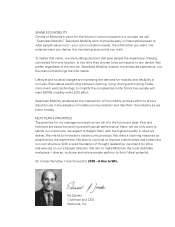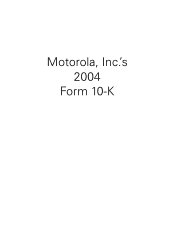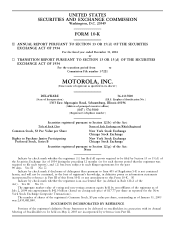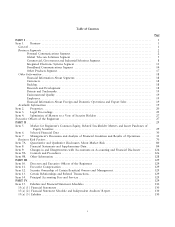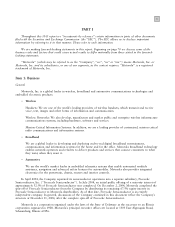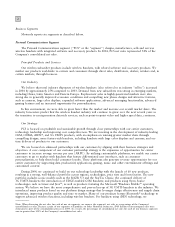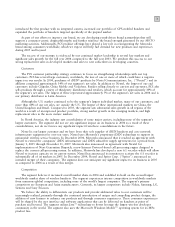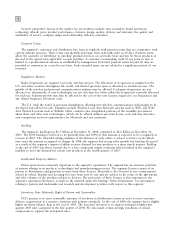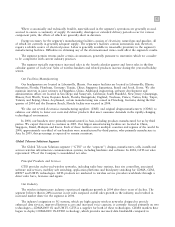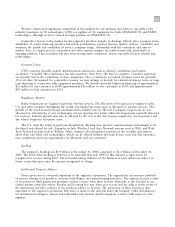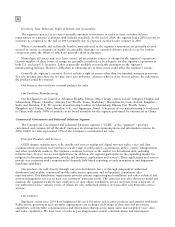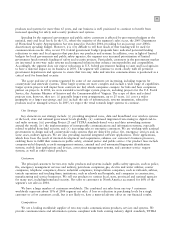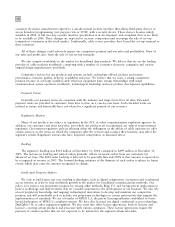Motorola 2004 Annual Report Download - page 14
Download and view the complete annual report
Please find page 14 of the 2004 Motorola annual report below. You can navigate through the pages in the report by either clicking on the pages listed below, or by using the keyword search tool below to find specific information within the annual report.
6
CDMA2000 1X. In addition, many GSM markets, particularly those in Western Europe, have begun to deploy
UMTS.
Our Strategy
We are executing on a strategy to enhance our position as an end-to-end supplier of wireless infrastructure.
GTSS continues to invest in major radio access technologies: CDMA2000 1X, CDMA2000 1X-EVDO, iDEN»,
GSM, GPRS (General Packet Radio Service, which is a 2.5G technology), EDGE (a technology that provides data
bandwidth higher than GPRS in existing GSM spectrum assignments), UMTS and HSDPA (High Speed Downlink
Packet Access, an evolution from UMTS technology that oÅers improved performance beneÑts and reduced costs
to operators). In 2004, GTSS deployed its soft switch product in certain markets in Asia and Latin America. The
market for wireless soft switch continues to grow, and we believe GTSS is a leader in providing these next-
generation wireless soft switch IP networks.
Our network products are further enhanced by a portfolio of services that reduce operator capital expenditure
requirements, increase network capacity and improve system quality. These quality improvements beneÑt operators
through increased customer satisfaction, greater usage and lower churn, all of which can have a positive impact on
operator Ñnancial results. GTSS also expanded its market presence in emerging markets, many of which have higher
subscriber growth rates than those in mature markets.
We also continue to build on our industry-leading position in push-to-talk over cellular (PoC) technology. We
have executed agreements to launch our PoC product application on both GPRS and CDMA2000 1X networks. To
date, the segment has 23 contracts in 27 countries.
Customers
Due to the nature of the segment's business, the agreements it enters into are primarily long-term contracts
with major operators that require sizeable investments by customers. In 2004, Ñve customers represented
approximately 54% of the segment's net sales (China Mobile; China Unicom; KDDI, a service provider in Japan;
Nextel and its aÇliates; and Verizon). The loss of any of the segment's large customers, in particular these
customers, could have a material adverse eÅect on the segment's business. Further, because contracts are long-term,
the loss of a major customer would impact revenue and earnings over several quarters.
Nextel is our largest customer, representing 17% of the segment's net sales in 2004, and we have been their
sole supplier of iDEN handsets and core network infrastructure equipment for over ten years. Nextel uses
Motorola's proprietary iDEN technology to support its nationwide wireless service business. In December 2004,
Motorola announced that it reached an agreement with Nextel to extend the companies' iDEN infrastructure and
iDEN subscriber supply agreements for a period from January 1, 2005 through December 31, 2007. Motorola also
announced an agreement with Nextel for implementation of Next Generation Dispatch, a new Internet Protocol-
based call processing engine designed to replace the current call-processing system. In addition, Motorola has
developed a new 6:1 vocoder which will allow Nextel to increase capacity on its current system. Nextel has
announced its intention to activate the 6:1 vocoder in substantially all of its markets in 2005. In December 2004,
Nextel and Sprint announced an intended merger of their companies. The segment does not anticipate any
signiÑcant impact to its business in 2005 as compared to 2004 as a result of this merger.
KDDI has been successful with its all-Motorola 800MHZ CDMA2000 1X network in Japan. In 2004,
Motorola and KDDI began deployment of a CDMA2000 1X network in the 2GHZ band. This new packet-based
2GHz network is expected to allow KDDI to provide more advanced features and expand its subscriber base.
Competition
GTSS experiences competition in worldwide markets from numerous competitors, ranging in size from some of
the world's largest companies to small, specialized Ñrms. Ericsson has maintained its market leadership position. Five
vendors with similar market share positions including Motorola, Nokia, Siemens, Lucent and Nortel trail Ericsson.
Alcatel, Samsung and NEC are also signiÑcant competitors. Competition will continue to intensify as new Chinese
infrastructure vendors like Huawei and ZTE enter the market.


